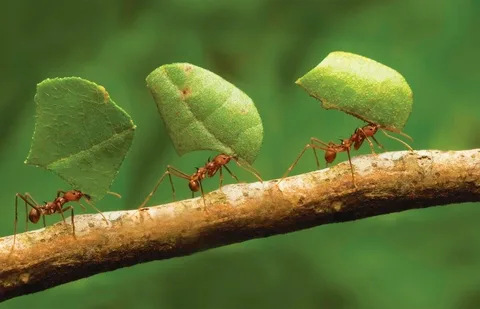Ants are among the most fascinating and abundant insects on Earth. They belong to the family Formicidae and are found in nearly every corner of the planet, with the exception of Antarctica.
Ants are social creatures, known for their highly organized colonies and complex social structures.
There are over 12,000 species of ants, each exhibiting unique behaviors and adaptations that allow them to thrive in a variety of environments.
Physical Characteristics
Ants have three main body parts: the head, thorax, and abdomen. Their heads feature large mandibles used for carrying food, defending the colony, and interacting with other ants.
Antennae on their heads are crucial for communication and navigation.
Ants have six legs, which are attached to the thorax, and their bodies are typically covered with a hard exoskeleton.
Social Structure
Ants are eusocial insects, meaning they live in structured colonies or nests, where individuals work together to achieve common goals such as foraging, defense, and reproduction.
A typical ant colony consists of three main types of ants:
- Queens: The reproductive females that lay eggs.
- Workers: Sterile females that perform tasks like foraging, cleaning, and caring for the young.
- Males: Their primary role is to mate with the queen.
Colonies can range from just a few ants to millions, depending on the species.
The organization of ant societies is often compared to human cities, with ants showing remarkable cooperation and division of labor.
Behavior and Communication
Ants communicate primarily through the use of chemicals called pheromones.
These chemical signals help ants to communicate the location of food sources, alert others to danger, or coordinate group activities.
When an ant finds food, it leaves a trail of pheromones back to the colony, which other ants follow.
Ants also exhibit collective behaviors such as building intricate nests, foraging in coordinated groups, and defending their colonies from predators.
Some species even engage in farming activities, cultivating fungi or herding aphids for their honeydew.

Ecological Importance
Ants play crucial roles in ecosystems. They are important decomposers, breaking down organic matter and recycling nutrients into the soil.
Their tunneling activities also aerate the soil, promoting plant growth.
In addition, ants are both predators and prey, helping to control the populations of other insects while providing food for birds, mammals, and other predators.
Conclusion
Ants may be small, but they are integral to the balance of many ecosystems.
Their complex social structures, cooperative behaviors, and diverse roles make them one of the most successful and enduring groups of organisms on the planet.
Whether they’re scavenging for food, defending their nests, or communicating through pheromones, ants continue to intrigue scientists and nature enthusiasts alike.



